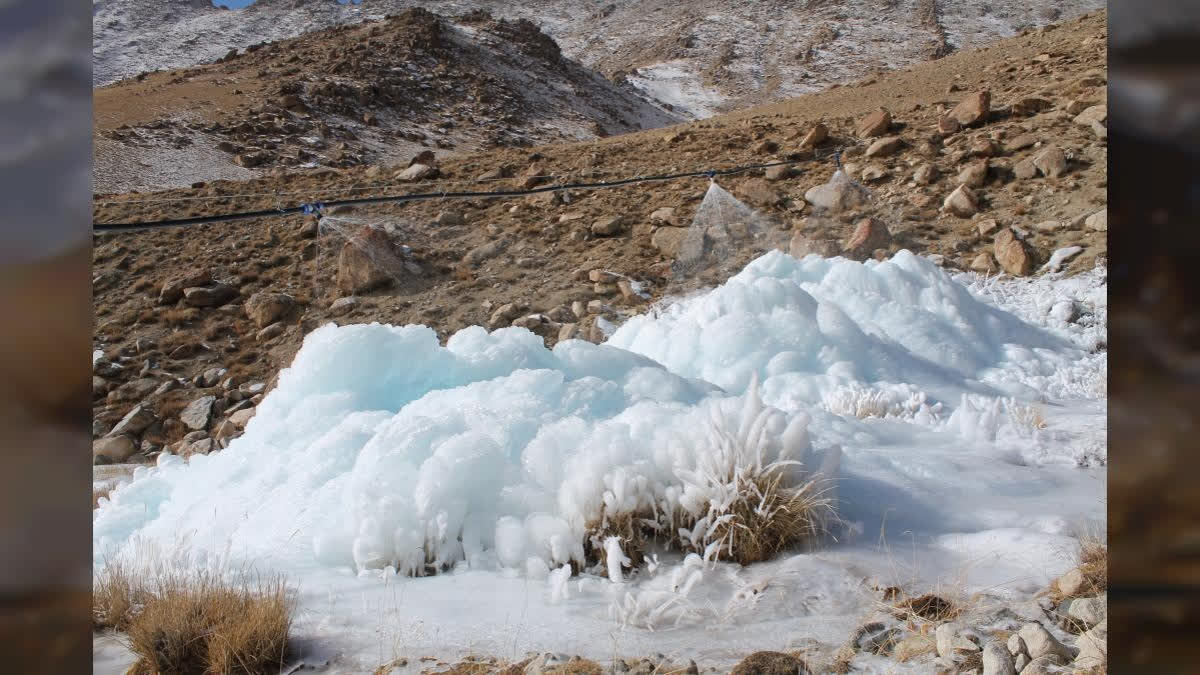Leh:The Automated Ice Reservoir in Sakti village near Warila Pass was on Monday inaugurated by Chief Executive Councillor, LAHDC, Leh Adv. Tashi Gyalson along with Executive Councillor, Agriculture, Stanzin Chosphel.
The project's main objective is to solve the region’s growing water scarcity issues and to harness winter water, which otherwise goes unused due to low seasonal demand.
The project was initiated by LAHDC, Leh through the Irrigation Department along with its sister departments and was tendered out to Acres of Ice.
Adv. Tashi Gyaltson said, "This is a fully automated vertical Ice Reservoir. The temperature controller regulates when to start or stop the sprinkler based on the temperature."
According to Gyaltson, this innovative technology requires minimal manpower and addresses a key challenge of operating such systems in extreme conditions.
"Typically, such innovations demand significant manpower, which is difficult to arrange as villagers cannot easily walk up to high-altitude valleys during winter to manually monitor machines and pipes. With this new automated system, manpower requirements are significantly reduced," Gyaltson said.
Gyaltson further explained that the system is self-monitoring, and drones will be used to access and survey the locations. "Additionally, a mobile app is under development to enable monitoring directly from a phone. This pilot project has been initiated on a trial basis in Sakti village. Based on its success, we plan to replicate it in other water-scarce villages across Ladakh," Gyaltson said.
Murtaza Ali, Executive Engineer of the Irrigation and Flood Control Division, explained, "This concept was initiated three months ago with the aim of extending the freezing window. When temperatures drop below freezing, water is sprayed, allowing it to freeze according to the atmospheric temperature."
"When temperatures rise above freezing, the spraying stops because spraying at higher temperatures causes the already-formed ice to melt. This method increases both the volume of ice and the duration of its existence," added Ali.
Basit Afzal, Co-Founder, of Acres of Ice, stated, "We have been working in Ladakh for the past eight years on water management. In the past, ice used to form naturally in homes, but now it no longer freezes as it once did. Additionally, the agricultural season is extending. Ladakh has immense potential and opportunities, but the number of users is still limited. It is, therefore, crucial to use water judiciously, whether for household needs, agriculture, or even adventure."
He added, "We were inspired by Chewang Norphel’s pioneering work. Wherever we go today, we find traces of his innovation in remote areas and shadow valleys across Ladakh. Unfortunately, no one is taking his efforts forward. That is why we decided to dedicate our time to replicating his ideas while integrating our own knowledge and expertise."
Afzal explained, "We have incorporated elements of automation to collect data, reducing the need for the local team to frequently visit the site. We are extending the freezing window. We can start the freezing from September during night time till May. We want to tap this window.”
Dr. Suryanarayanan, Co-Founder of Acres of Ice, on his part said, “This method of freezing water during winter can address water shortages in the spring season."
"We are using a different method to create ice structures using weather sensors, pressure sensors, and an automation system, making the process more efficient. This technique significantly benefits agriculture. Padma Shri awardee Chewang Norphel pioneered the concept of Ice Walls through bund systems in several villages across Ladakh. Many of these projects were successful, including one in Saboo village, where the ice lasts throughout the year. However, due to a lack of maintenance, many of these bunds are damaged," added Dr. Suryanarayanan.
